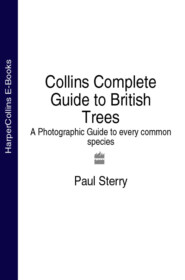
Полная версия:
Collins Complete Guide to British Trees: A Photographic Guide to every common species
LEAVES
Leaves are among the most conspicuous and distinctive features of any tree. They grow in a huge variety of shapes, sizes, colours and combinations and are usually the best feature for identifying the tree because of their unique structure. Leaves may vary from one species to another but they all perform the same vital function as the principal producers of food for the tree.
The first pair of leaves to emerge from the seed are simple, and bear no resemblance to the true leaves of the tree; they are derived from the seed’s food store. They are green, however, and supply the tiny seedling with its first food made from sunlight energy. Once the seedling has begun to produce leaves that are miniature versions of its true leaves, growth can begin very rapidly. Tiny seedlings are vulnerable to grazing, trampling, drought and competition, so very few survive.
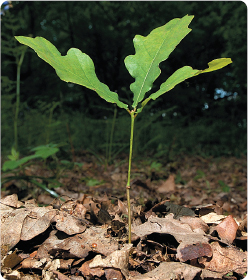
Recently germinated oak seedling.
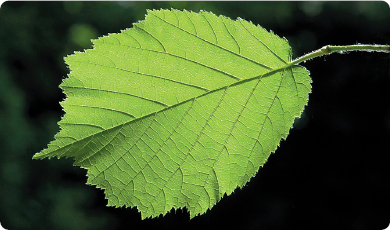
A plant’s leaves are its powerhouse, trapping energy from sunlight and converting it into basic food.
Leaves are basically thin layers of living tissue with the ability to trap light energy and use this to convert the raw materials of water and carbon dioxide into a simple sugar. This reaction, known as photosynthesis, is arguably the most important chemical reaction in the world, for it is the basis of all other food production. Animals do not have the ability to convert these simple materials into food; they have to rely on plants to do it for them. The simple sugar produced in the leaves is glucose, and this can be formed into a variety of other important materials, particularly starch, which many plants store, or pack into their seeds. A vital by-product of this reaction is oxygen, the gas essential for the respiration of all members of the animal kingdom. This explains the vital role of trees in the ecosystem: they are major consumers of carbon dioxide, one of the so-called ‘greenhouse gases’; and they are major producers of oxygen, the gas we need for our respiration. They are also major producers of food for much of the animal kingdom.
Contained within a leaf are numerous specialised cells. Some are concerned with the transport of materials in and out of the leaf, some are the vital energy-trapping cells that utilise sunlight, and others are concerned with the regulation of water movements. The cells that trap light-energy contain a light-absorbing pigment called chlorophyll, which gives leaves their green colour. Other pigments of different colours may be present in varying amounts, and it is this variety that gives leaves of different trees their own subtle shade of green. Without the green chlorophyll or other light-absorbing pigments, leaves would be unable to perform their important function, and also, if deprived of light, they would be unable to manufacture the tree’s food.
Leaves arrange themselves in such a way to absorb the maximum amount of sunlight, so spreading canopies or trees growing taller than their neighbours, are both ways in which trees maximise the light-gathering power of their leaves. Some leaves have paler patches that lack green chlorophyll; these are known as variegated leaves and certain trees, such as some cultivars of the Highclere hollies, regularly produce green-and-yellow leaves. If the leaves were completely lacking in chlorophyll they would be unable to manufacture food for the tree; the small areas of green tissue in the leaf produce all the food needed by the whole leaf.
All leaves have tiny pores in their surface (normally just the lower surface) called stomata. These allow water to evaporate into the atmosphere. To some extent the tree can regulate the opening and closing of these stomata, but during daylight hours, when the tree is trapping sunlight, they will be open, allowing water out and also allowing the circulation of the gases involved in photosynthesis. This can lead to problems for trees growing in hot, dry areas, or in well-drained soils where little ground water is available. In order to allow the essential gases to circulate, and at the same time minimising water loss, many leaves have become reduced in size, such as the needles of firs and pines, or have thick waxy upper surfaces such as the glossy green leaves of hollies and magnolias. This reduces water loss to a minimum without impeding photosynthesis.
The great variety of leaf shapes and sizes is an indication of the variety of ways in which trees can cope with environmental conditions. Some trees grow in areas where water is at a premium, so they have small leaves, to cut down on water loss through their thin skins. Some grow in shady conditions, so they may have larger leaves that can trap the maximum amount of light energy. Some trees are subject to grazing by animals, so their leaves are spiny or prickly, or protected on tough, thorny stems.
Beech

OVAL AND ENTIRE
Hornbeam

ELLIPTICAL AND TOOTHED
Small-leaved Lime
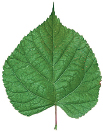
CORDATE
Red Oak
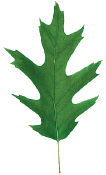
LOBED
Horse-chestnut
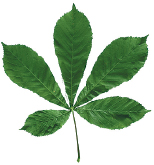
PALMATE
White Ash

COMPOUND
Yew

NEEDLE-LIKE
Scots Pine

WITH PAIRED NEEDLES
Leaf types.
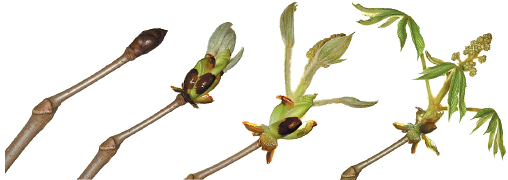
Deciduous trees, such as Horse-chestnut, produce fresh leaves each spring, which burst forth from buds.
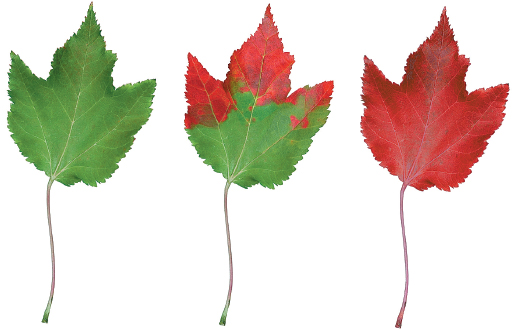
Autumn leaf colour is spectacular in many maple species: as chlorophyll and other pigments are withdrawn, remaining red pigments prevail.
Evergreen trees do not lose all their leaves at the end of every growing season; most leaves remain on the tree through the winter, although there is always some loss and some replacement. In many of the pines, for example, the needles will remain on the tree for about 3 years. As the shoot grows longer each year, a new set of needles grows on the tip of the lengthening shoot. The older needles, finding themselves further and further away from the tip, gradually fall off. Small leaf scars remain, and these are quite distinctive in some species and may be a useful aid to identification. Broadleaved trees such as Holly also replace their leaves gradually so there is always some leaf-fall, but plenty of green foliage remains on the tree.
Deciduous trees generally shed all their leaves at the end of the growing season, before the onset of winter. Many of them produce spectacular displays of colour before the leaves finally fall. These colour changes are the result of the gradual withdrawal back into the tree of all the useful materials in the leaf; as the various pigments are removed the leaf itself changes colour until finally a corky layer, called the abscission layer, grows at the base of the petiole or leaf stalk. This seals off the shoot and when the leaf finally falls, a scar is left through which mould spores and other harmful materials are unable to pass. The twigs of Horse-chestnut have very distinctive leaf scars that look like tiny horseshoes. If these are examined carefully through a hand-lens, the sealed-off ends of the vessels that conducted materials in and out of the leaves can clearly be seen.
There may be as many as 250,000 leaves on a mature oak tree, whilst a large spruce probably has 10 times as many, in the form of needles. The oak’s leaves will be shed at the end of the growing season, adding to the rich accumulation on the ground beneath it, whilst the spruce’s needles will be shed and replaced gradually, each individual needle remaining on the tree for about 4 years.
REPRODUCTION
Trees normally produce flowers when they are several years old. Beech, for example, produces its first flowers at around 30 years old, repeating the process each spring for the next 200 years if it remains healthy. Some trees, such as apples or oaks, have years in which they produce a large crop of fruits or seeds, followed by other years with hardly any, whilst other species, such as some maples, produce a good seed crop year after year.

Even a slight breeze will liberate pollen from the male catkins of Hazel
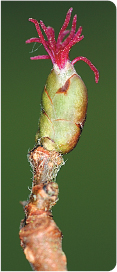
Carry it to female flowers.
Some trees and shrubs produce conspicuous flowers to attract pollinating insects, something that, in ornamental trees, we also find attractive. Honey Bees are particularly important pollinators, but numerous other insects visit the flowers for nectar and pollen. Many flowering trees have also long been prized by gardeners for their scent.
Many trees are pollinated by the wind. Their flowers are less conspicuous, often taking the form of catkins, which are pendulous and usually open before the leaves so that nothing impedes the free movement of the pollen grains. Wind-pollinated flowers normally have flowers of separate sexes, the males usually being larger and more abundant. Many wind-pollinated trees are such prolific producers of pollen that on warm breezy days in spring clouds of pollen can sometimes be seen blowing from the trees.
Conifer flowers are either male or female, and borne on the same or different trees. There are no petals, but some of the flowers are still quite colourful and decorative. Male flowers are short-lived, falling off after they have released clouds of pollen, but the female flowers, often covered with brightly coloured scales, remain on the tree after pollination and develop into cones containing the seeds. They rely on the wind for pollination and also for seed dispersal. A few close relatives of the conifers, such as the yews, produce fleshy fruits instead of cones.
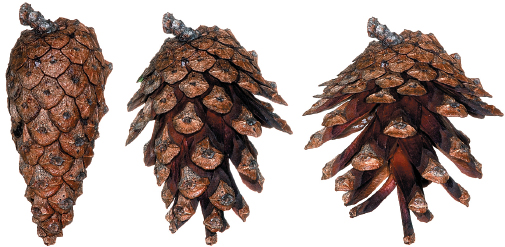
Mature cones open and close in response to temperature and humidity, releasing seeds in hot, dry conditions.
The flowers of broadleaved trees and shrubs are usually hermaphrodite, containing both male and female parts, but there are a number of exceptions. Both sexes usually have petals in some form or other and they may also be scented. Small flowers are often grouped together in larger clusters to help attract pollinating insects. Some are wind-pollinated and open early in the year before the leaves, but insect-pollinated flowers usually open in spring and summer when more insects are active.
The fruits of trees and shrubs are much more varied than the cones of the conifers. They range from tiny papery seeds with wings, through nuts and berries, to large succulent fruits in a variety of shapes and colours. Edible fruits are designed to assist dispersal of the seeds by animals and many are delicious to the human palate.
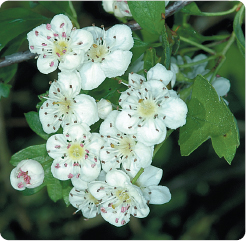
Hawthorn flowers are an attractive sight in spring and are irresistible to pollinating insects.
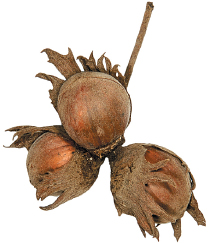
HAZEL – NUTS
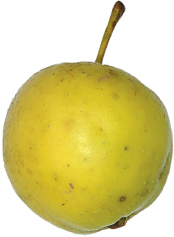
CRAB APPLE – FLESHY FRUIT
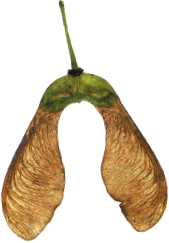
SYCAMORE – WINGED SEEDS
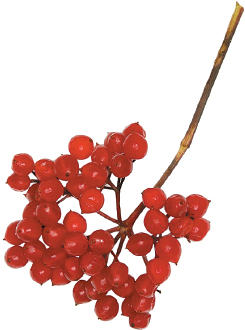
GUELDER-ROSE – BERRIES
The fruits of broadleaved trees and shrubs come in a range of shapes and size, including winged seeds, hard-cased nuts, luscious berries and juicy fruits.
WHAT IS A TREE?
Nobody could have any doubt that a mature Wellingtonia or an ancient, spreading Pedunculate Oak is a tree, but would a prostrate Juniper, or a Creeping Willow, also qualify, or are they merely shrubs? One feature common to both trees and shrubs is that their stems increase in thickness each year by the laying down of internal layers of woody tissue in the form of concentric rings. This secondary thickening builds up year by year to increase the diameter of the stem and gives a permanent record of the age of the tree or shrub.
Trees are generally considered to have a single main stem of 5m or more in height with a branching crown above this, whereas shrubs may have numerous stems arising at ground level and may not normally reach the height of a tree. Both trees and sizeable shrubs are covered in this book but the distinction is not always clear. Individuals of the same species may become trees or form shrubs, depending on the circumstances in which they are growing, or their management. Hazel, for example, forms a multi-stemmed shrub in response to coppicing, or cutting back to the rootstock; each time this is done, new shoots arise from the rootstock and the Hazel regenerates. If this cutting back does not take place, it can grow as a medium-sized tree on a single stem.
Trees do not belong to a single family of plants; many plant families are represented, and some, like the Fabaceae and Rosaceae, also include many herbaceous plants and shrubs as well as large trees.
The plant kingdom is divided into two main classes, the Gymnosperms and the Angiosperms. The most primitive of the two classes is the Gymnosperms, the name meaning ‘naked seeds’; the ovule is borne on a bract and not enclosed in a seedpod or case. This class includes the Maidenhair Tree, a very primitive tree, and all the conifers, or cone-bearing trees.
The name Angiosperm means ‘hidden seeds’ and refers to the way the seeds are contained inside an ovary, a structure that may later develop into a seedpod or fruit. This large class includes many well-known plant families, some of which are mostly made up of herbaceous plants, and some of which are mostly composed of trees. The Limes (Tiliaceae) and Elms (Ulmaceae), for example, are mostly trees, whilst trees feature in only one of many genera in the Foxglove family (Scrophulariaceae). All of our garden and wild flowers, bulbs, palms and the grasses and cereals are Angiosperms.
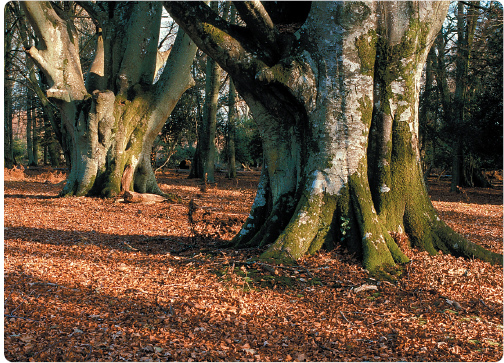
With their massive trunks, there is no mistaking that these Common Beeches are indeed trees.
Конец ознакомительного фрагмента.
Текст предоставлен ООО «ЛитРес».
Прочитайте эту книгу целиком, купив полную легальную версию на ЛитРес.
Безопасно оплатить книгу можно банковской картой Visa, MasterCard, Maestro, со счета мобильного телефона, с платежного терминала, в салоне МТС или Связной, через PayPal, WebMoney, Яндекс.Деньги, QIWI Кошелек, бонусными картами или другим удобным Вам способом.
Вы ознакомились с фрагментом книги.
Для бесплатного чтения открыта только часть текста.
Приобретайте полный текст книги у нашего партнера:
Полная версия книги
Всего 10 форматов



